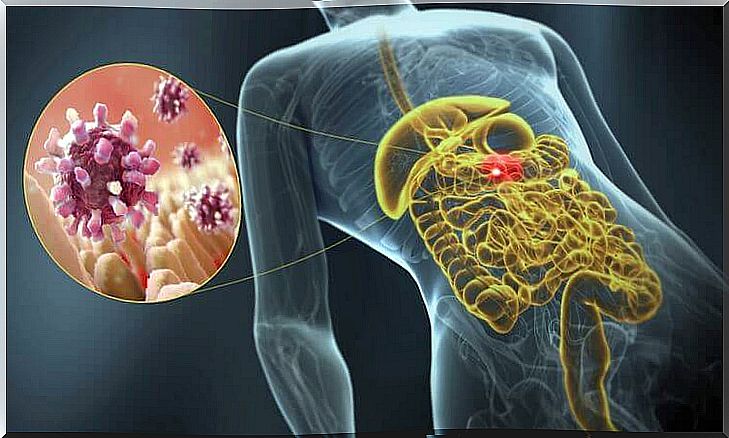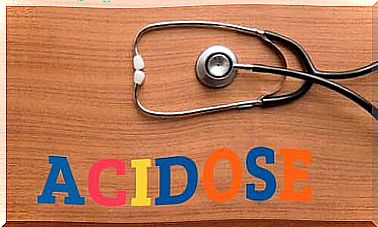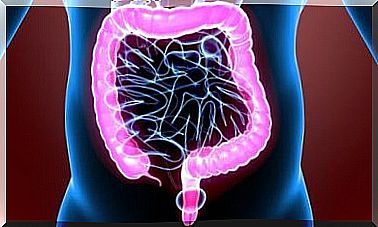Stomach Flu: Every Cause You Need To Know

Stomach flu is the common name for gastroenteritis. It is a clinical condition in which diarrhea and vomiting can develop as a result of inflammation of the gastrointestinal tract.
What is stomach flu?
Stomach flu is a syndrome that results in diarrhea and vomiting, and is caused by inflammation of the gastrointestinal tract. In addition, abdominal pain and cramping can occur, and in more severe cases it can cause dehydration.
The most common cause of stomach flu is an infection. In this sense, viruses are the most common microorganisms in children. In adults, these are bacteria.
Who can be affected?

Stomach flu is currently one of the most common syndromes, with between 3 and 5 billion cases per year. It is one of the main reasons for doctor’s appointments in developed countries, leading to very high economic costs.
The greatest risk of infection occurs during rainy seasons or during winter, due to a decrease in water quality.
It can affect anyone, but it is most common in children, especially under the age of 5, as the adults may have developed an immunity.
It is very common in developing countries. This is often due to cholera, as there are many areas where hygiene is poor and the water is contaminated, putting a high risk of epidemics.
Causes of stomach flu

As mentioned above, viruses and bacteria are the main causes of the syndrome. But stomach flu can also be caused by parasites. There are also a number of cases due to non-infectious causes, such as Crohn’s disease or lactose intolerance.
Viruses
- Rotavirus
- norovirus
- adenovirus
- Astrovirus
Rotavirus is the main cause in children, as the risk of infection is also very high due to their lack of immunity and poor hygiene. In adults, the norovirus is often the main culprit, especially in America.
Viruses are responsible for more than 70% of infectious diarrhea during childhood. This is because the children have a less developed immune system than adults.
bacteria
- Escherichia Colic
- Campylobacter jejuni
- Salmonella
- Clostridium difficile
- Vibrio cholerae
Bacteria often cause stomach flu through food contamination. If the food is kept at room temperature, bacteria will multiply and the chance of infection increases.
Campylobacter jejuni mainly infects raw or undercooked meat.
Cholera is a disease caused by V. cholerae, which is transmitted through contaminated food and/or water. Cholera is a leading cause of stomach flu, especially in countries in Africa and Asia.
The use of antibiotics sometimes also promotes stomach flu. One of the causes of diarrhea that particularly affects the elderly and hospitalized patients is a Clostridium difficile infection .
How is it transferred?
Infection can occur in several ways. The most common way is through physical contact with contaminated people or contaminated food or water.
The greatest risk of infection worldwide occurs during rainy seasons or during winter, due to the decline in water quality.
Infection is also associated with poor hygiene and malnutrition, which usually occur in children. However, the causes of stomach flu are so diverse that it is impossible to define a single method of infection.
Incubation period and infection period

The symptoms of stomach flu usually appear 1 to 3 days after contracting the infection.
The duration of stomach flu is variable. The diarrhea and vomiting usually disappear between the first 3 and 8 days. But if not treated properly, the diarrhea can become chronic.
On the other hand, it is noteworthy that adults can develop immunity so that they can be carriers of certain infectious agents and not have an infection themselves. In other words, people can remain contagious after the symptomatic period, so it is imperative that you maintain the precautions.
Symptoms of stomach flu
- Vomit
- Diarrhea: If the cause is bacterial, blood may appear in the stool
- Stomach ache
- Cramp
Viral stomach flu also occurs with fever, fatigue, and muscle aches.
Complications
The most common complication of stomach flu is dehydration due to diarrhea. Dehydration is classified as:
- mild (<5%)
- moderate (5 – 9%)
- severe (>10%).
In moderate and severe dehydration, sunken eyes, lack of tears, and dry mouth are present. In addition, the person is less active and the skin loses its elasticity.
Differential diagnosis
This is a scientific method to be able to make a diagnosis with the data available at that time. Lists have been drawn up for this purpose, of which the complaints are more or less similar.
- volvulus
- Diabetes mellitus
- Appendicitis
- celiac disease
- Food poisoning
- Abuse of laxatives
- Irritable bowel syndrome
The diagnosis of stomach flu is clinical, so it is necessary to exclude other pathologies.
Therapy

Treatment will mainly be based on rehydration and proper nutrition. It is better not to consume drinks that contain sugar as they can aggravate the diarrhea.
Rehydration can be done by means of oral rehydration salts or pure water, in case the former is not available.
It is recommended to maintain a normal diet, reducing sugar intake and increasing that of probiotics. Some cases of stomach flu can be treated with antiemetics, antibiotics and antispasmodics, but this is uncommon.
Prevention and vaccination
The main preventive measures are good hygiene and the consumption of uncontaminated water and food. The hand washing reduces the risk of infection by up to 30%.
Rotavirus vaccination programs are currently being implemented which are highly effective worldwide.









